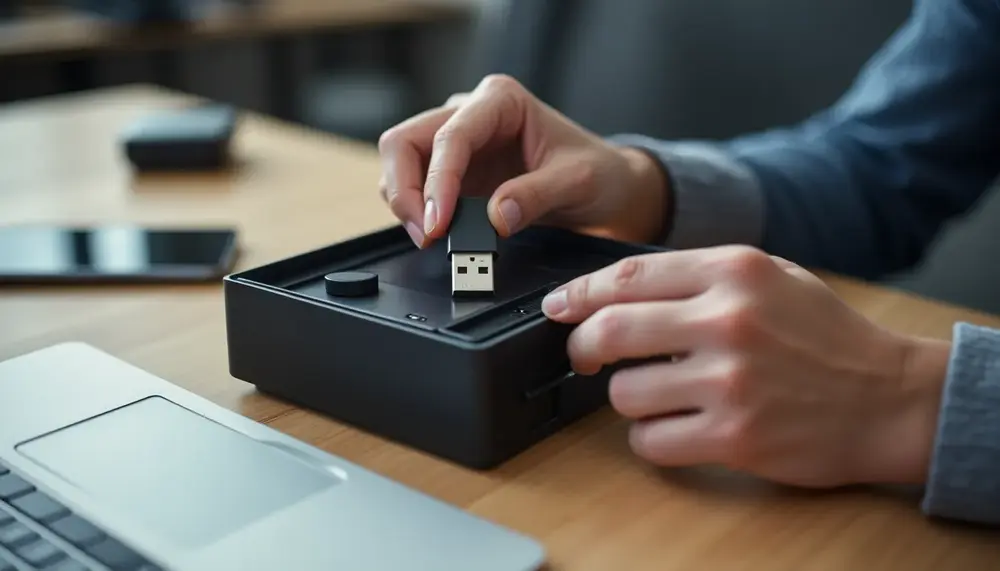Table of Contents:
Understanding the Importance of Your Crypto Wallet’s Private Key
Grasping the real significance of your crypto wallet’s private key is not just a matter of digital hygiene—it’s the linchpin between you and your assets. This unique string, generated cryptographically, isn’t merely a password or a PIN. It’s the one and only cryptographic proof that you own and control the funds associated with your wallet. Without it, access is mathematically impossible; with it, anyone can transfer your assets in seconds. That’s not just theory—there’s no “forgot password” option in the blockchain universe.
What makes the private key so crucial? Unlike centralized banking, where a lost password can be reset after a quick call, crypto systems are deliberately trustless. The private key is the only credential that matters. If someone else obtains it, they have the same authority as you. If you lose it, your assets are irretrievable—no appeals, no customer support, no exceptions. The irreversible nature of blockchain transactions amplifies the stakes: a single slip can mean permanent loss.
But here’s a less obvious angle: your private key is not just a tool for spending; it’s also a shield. It prevents unauthorized parties from forging transactions or accessing your holdings. The cryptographic design ensures that only the holder of the private key can initiate valid transactions, providing both security and autonomy. This double-edged power is what makes safeguarding your private key so fundamentally important—there’s no backup system unless you create one yourself.
Concrete Threats: What Can Happen If Your Private Key Is Compromised
When your crypto wallet’s private key falls into the wrong hands, the consequences are immediate and, honestly, pretty brutal. The threat landscape is more than just theoretical—real-world incidents have shown how quickly digital assets can vanish once a key is exposed. Here’s what you’re actually up against:
- Instant Asset Drain: Attackers can transfer all your funds to their own wallets in seconds. There’s no waiting period, no reversal, and no authority to appeal to. Once it’s gone, it’s gone.
- Targeted Phishing and Malware: Sophisticated malware or phishing attacks can specifically hunt for private keys stored on devices or in cloud backups. These attacks often go unnoticed until the damage is done.
- Permanent Loss of Control: If someone else uses your private key, you lose all ability to access or recover your assets. Even if you notice the breach, you can’t stop transactions already in progress.
- Ransom and Extortion: In some cases, attackers may demand payment to return stolen assets or threaten to expose your holdings, especially if you’re a high-profile target.
- Exposure of Linked Identities: If your wallet is tied to other personal information, a compromised key can lead to further identity theft or targeted attacks against your online presence.
In short, a compromised private key doesn’t just mean losing money—it can trigger a cascade of security, privacy, and even reputational risks that are almost impossible to reverse.
Practical Step-by-Step Methods to Secure Your Private Key
Securing your private key is not rocket science, but it does demand careful, deliberate action. Here’s a hands-on, no-nonsense approach you can follow right now to dramatically reduce your risk of compromise:
- Generate Keys Offline: Always create your wallet and private key on a device that is not connected to the internet. This reduces exposure to malware or remote attacks during the most vulnerable moment—key creation.
- Use Dedicated Hardware: Invest in a reputable hardware wallet. These devices are designed to keep your private key isolated from your computer and the internet, making remote theft virtually impossible.
- Physically Separate Backups: Store backup copies of your private key or recovery phrase in physically separate, secure locations. Think fireproof safes, bank safety deposit boxes, or even a trusted family member’s vault. Never keep all backups in one place.
- Handwritten Records Only: If you must write down your private key or recovery phrase, do it by hand. Avoid printers, screenshots, or digital notes, as these can leave traces on devices or in the cloud.
- Enable Two-Factor Authentication (2FA): For wallets and services that support it, activate 2FA. While it doesn’t protect the private key itself, it adds a critical layer if someone tries to access your wallet interface.
- Regularly Audit Access: Periodically check who has access to your private key or backups. Remove any unnecessary copies and update your storage strategy if your circumstances change (like moving house or changing trusted contacts).
- Practice “Need to Know” Principle: Only share information about your key’s storage with those who absolutely need to know. The fewer people aware of your security setup, the lower your risk.
By following these steps, you’re not just locking a digital door—you’re building a fortress around your crypto assets. It’s a bit of effort, sure, but the peace of mind is absolutely worth it.
Essential Storage Strategies: Hot vs. Cold and Hybrid Solutions
Choosing the right storage strategy for your private key is not just a technical detail—it’s a critical decision that shapes your overall security. The main approaches are hot storage, cold storage, and hybrid solutions, each with distinct advantages and risks.
- Hot Storage: This method keeps your private key on a device connected to the internet, such as a mobile app or desktop wallet. While it offers quick access for frequent transactions, it also exposes your key to online threats. Hot storage is best reserved for small, active balances you’re comfortable risking.
- Cold Storage: Here, your private key is stored entirely offline, using methods like hardware wallets, air-gapped computers, or even a handwritten note locked away. Cold storage drastically reduces the risk of remote hacking, making it ideal for long-term holdings or significant sums you don’t need to move often.
- Hybrid Solutions: Some users combine both approaches for flexibility and security. For example, you might keep a small amount in a hot wallet for daily use, while the bulk of your assets remain in cold storage. Advanced setups sometimes involve multisignature wallets, where spending requires approval from both hot and cold devices, adding an extra layer of control.
Ultimately, the best strategy depends on your habits, risk tolerance, and the value you’re protecting. Mixing methods—when done thoughtfully—can offer both convenience and robust protection against a wide range of threats.
How to Create Effective Backups Without Increasing Your Risk
Backing up your private key or recovery phrase is absolutely essential, but it’s a balancing act: you want to ensure access in an emergency, without making yourself an easy target. Here’s how to create backups that are both reliable and discreet, without accidentally inviting disaster.
- Use Redundancy with Caution: Make more than one backup, but don’t scatter them everywhere. Two or three copies, each in a different secure location, are usually enough. More copies just mean more risk.
- Opt for Tamper-Evident Storage: Place backups in envelopes or containers that show if someone has tried to access them. This way, you’ll know if your backup has been compromised before you need it.
- Split the Backup (Shamir’s Secret Sharing): For extra-sensitive holdings, consider splitting your recovery phrase into parts using cryptographic techniques. Each part alone is useless, but together they restore access. Store the parts separately.
- Physical Protection from Elements: Store backups in waterproof and fireproof containers. Paper can be destroyed by water or fire, and even metal backups can corrode if not protected.
- Keep a Clear Access Plan: Document who knows about the backups and how to access them, but don’t put this information in the same place as the backup itself. If you’re incapacitated, a trusted person should be able to retrieve your backup—without having all the details in one spot.
- Test Your Backup Process: Periodically check that your backup is still readable and that you remember the recovery process. There’s nothing worse than a backup that fails when you need it most.
Smart backups aren’t just about duplication—they’re about strategic placement, protection, and ensuring only the right people can ever use them. Think like a chess player, not a gambler.
Best Practices for Managing Recovery Phrases and Backups
Managing your recovery phrase and backups isn’t just about hiding them away—it’s about creating a sustainable, practical system that stands the test of time and unexpected events. Here’s how to keep your safety net both accessible and private, without falling into common traps:
- Rotate and Refresh Regularly: Update your recovery phrase and backups if you suspect any exposure or after major life changes (like moving or changes in trusted contacts). Don’t let outdated information undermine your security.
- Document Access Procedures: Write down clear, step-by-step instructions for accessing and using your recovery phrase, but store these separately from the phrase itself. This helps your future self—or a trusted person—avoid confusion in stressful situations.
- Limit Digital Footprints: Never store your recovery phrase in cloud services, email drafts, or digital note apps. Even encrypted files can become vulnerable if your device or password is compromised.
- Establish an Inheritance Plan: Decide how your recovery phrase will be passed on in case of death or incapacity. Legal tools like wills or trusted third-party services can ensure your assets aren’t lost forever, but details must be precise and secure.
- Monitor for Environmental Risks: Consider threats like humidity, pests, or even ink fading over years. Use archival-quality materials or specialized backup tools designed for longevity.
- Practice Discreet Communication: If you must inform someone about the existence or location of a backup, use vague language and avoid revealing specifics unless absolutely necessary. The fewer details in circulation, the better.
Effective management is proactive, not reactive. Treat your recovery phrase as a living part of your security plan—review, adapt, and communicate only as much as truly needed.
Examples of Safe Storage: Real-World Scenarios and Tools
Safe storage of private keys is not just theory—people and organizations have developed clever, real-world solutions that blend security with practicality. Let’s look at some concrete examples and the tools that make them work:
- Steel Backup Plates: Instead of paper, some users engrave their recovery phrase onto stainless steel plates. These plates are fireproof, waterproof, and corrosion-resistant, making them ideal for long-term storage in unpredictable environments.
- Multisignature Wallets: Businesses and families often use multisig wallets, where several private keys are required to authorize a transaction. For example, a company might require signatures from three out of five board members, each storing their key in a separate country for redundancy and legal compliance.
- Geographic Distribution: High-net-worth individuals sometimes split backups between a home safe, a lawyer’s office, and a bank deposit box in another city. This strategy protects against localized disasters and theft.
- Specialized Custody Services: Institutional investors may use regulated crypto custody providers, which employ air-gapped vaults, biometric access controls, and 24/7 surveillance. These services often include insurance coverage for stored assets.
- Hidden-in-Plain-Sight Methods: Some people disguise their backups—engraving phrases on the back of a photo frame or hiding metal plates inside household objects. While unconventional, these methods add an extra layer of obscurity against casual discovery.
Each of these scenarios demonstrates that with a bit of creativity and the right tools, you can dramatically improve the safety of your private key without making your life unnecessarily complicated.
Common Mistakes to Avoid When Safeguarding Your Private Key
Even the most security-conscious crypto users can slip up if they’re not aware of the subtle pitfalls that come with private key management. Here are several all-too-common mistakes you’ll want to sidestep if you’re serious about safeguarding your assets:
- Relying on Memory Alone: Trusting yourself to remember a complex private key or recovery phrase is a gamble. Stress, time, or unexpected events can make recall impossible when you need it most.
- Using Predictable Hiding Spots: Stashing your backup under a mattress, in a desk drawer, or behind a picture frame might seem clever, but these are the first places a thief will check. Avoid obvious locations at all costs.
- Sharing Details in Casual Conversation: Mentioning where or how you store your key—even in passing—can create a security risk. Information spreads quickly, sometimes in ways you don’t expect.
- Neglecting to Update After Life Changes: Failing to refresh your backup or access plan after moving, relationship changes, or major purchases can leave your assets exposed or inaccessible.
- Assuming All Hardware Wallets Are Equal: Not all devices are created with the same security standards. Using unvetted or cheap hardware wallets can introduce vulnerabilities or even backdoors.
- Overlooking Physical Security: A high-tech backup is worthless if it’s left in an unsecured or easily accessible location. Always consider both digital and physical threats.
- Ignoring Legal and Tax Implications: Failing to account for inheritance, legal access, or tax documentation can create headaches for you or your heirs, potentially locking away funds forever.
By steering clear of these missteps, you dramatically improve your odds of keeping your crypto safe—no unnecessary drama, just solid peace of mind.
Quick Security Checklist: Immediate Actions for Private Key Protection
When you need to boost your private key security right now, focus on actions that have immediate impact and don’t require complex planning. Here’s a sharp, actionable checklist for instant protection:
- Disconnect Unused Devices: Remove your private key from any devices you no longer use or control, such as old phones or laptops. Wipe these devices securely to eliminate digital traces.
- Review App Permissions: Check all wallet-related apps and browser extensions for unnecessary permissions. Revoke access for anything you don’t absolutely trust or need.
- Inspect for Physical Tampering: Quickly examine your physical backup locations for signs of disturbance or tampering—especially after travel, moving, or having guests.
- Update Anti-Malware Software: Ensure your primary device has the latest anti-malware definitions and run a full scan to catch potential threats before they escalate.
- Change Default PINs and Passwords: If you’re using a hardware wallet or safe, update any default codes or passwords to something unique and not easily guessed.
- Minimize Exposure During Transactions: When sending or receiving crypto, close unrelated apps and disconnect from public Wi-Fi to reduce the risk of interception.
- Enable Device Encryption: Turn on full-disk encryption for computers and phones that ever handle your private key, adding a crucial barrier if your device is lost or stolen.
Take these steps now—no need to wait for a rainy day. Each one is a quick win for your crypto security posture.
Conclusion: Taking Full Responsibility for Your Crypto Wallet Security
Owning your crypto security means stepping beyond passive habits and embracing a mindset of ongoing vigilance and adaptation. The digital landscape shifts quickly—threats evolve, new tools emerge, and even your own circumstances can change overnight. That’s why true responsibility isn’t a one-time setup; it’s a living process that requires you to stay curious, question your routines, and proactively seek out improvements.
- Stay informed: Subscribe to trusted security bulletins and follow updates from hardware wallet manufacturers or crypto security experts. New vulnerabilities or best practices can surface at any time.
- Test your recovery process: Don’t just assume your backup works—periodically walk through the recovery steps in a safe environment to ensure you (or your trusted contacts) can actually restore access if needed.
- Re-evaluate trust relationships: As your life changes, so does your circle of trust. Regularly reconsider who knows about your backups or has access to recovery information, and update your plans accordingly.
- Balance convenience and security: Find your personal sweet spot. Overly complex systems can lead to mistakes or neglect, while too much convenience can leave you exposed. Adjust as your needs and experience grow.
Taking full responsibility isn’t about paranoia—it’s about empowerment. With a thoughtful, evolving approach, you transform crypto security from a source of anxiety into a foundation for long-term confidence and freedom.
FAQ on Securing Your Crypto Wallet Private Key
What is a crypto wallet private key and why is it important?
A private key is a unique cryptographic string that grants access to your crypto funds. Anyone with this key can control your assets. Losing it means losing access permanently, and if someone else gets it, they can steal your funds instantly.
What are the best practices for storing my private key safely?
The best practices include using a hardware wallet, keeping handwritten backups in physically secure and separate locations, never storing your key digitally or online, and using tamper-evident and waterproof storage for backups.
Should I use hot or cold storage for my private key?
Hot storage allows quick access but is more vulnerable to online attacks. Cold storage, like hardware wallets or paper backups, keeps your key offline and much safer. For large amounts or long-term holdings, cold storage is highly recommended.
How can I create a reliable backup of my private key or recovery phrase?
Create multiple handwritten or engraved backups, store them in different secure locations, and never keep digital copies. Use fireproof and waterproof materials, and consider splitting the recovery phrase for extra safety.
What mistakes should I avoid when managing my crypto wallet’s private key?
Avoid relying on memory alone, storing the key or recovery phrase digitally, using obvious hiding spots, and sharing details in conversation. Always update your backup plan after major life changes and test your recovery process regularly.












